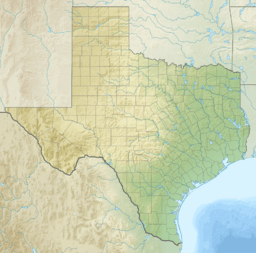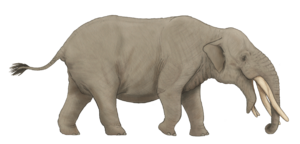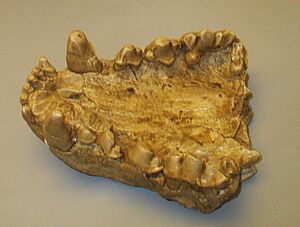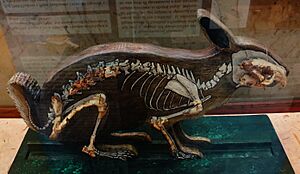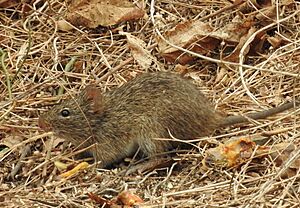Mount Blanco facts for kids
Quick facts for kids Mount Blanco |
|
|---|---|
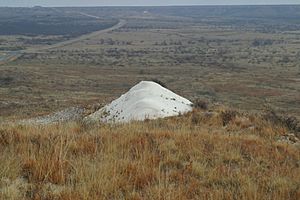
Mount Blanco viewed from above
|
|
| Highest point | |
| Elevation | 3,074 ft (937 m) |
| Geography | |
| Geology | |
| Age of rock | Late Blancan ?2.5-1.8mya?, Early Pleistocene |
| Mountain type | Butte |
Mount Blanco is a small, white hill in Crosby County, Texas. It's like a leftover piece of land that has been shaped by wind and water over a very long time. This special hill is found on the eastern edge of a large flat area called the Llano Estacado, inside a valley known as Blanco Canyon.
Mount Blanco is important because it's the main place where scientists first studied the Blanco Formation. This is a layer of rock and soil from the early Pleistocene period, which was about 2.5 to 1.8 million years ago. It's also where the Blancan fauna was first identified. This refers to a group of ancient animals whose fossils are found across North America from that time. Mount Blanco is a key site for understanding life during the Late Blancan age.
Contents
What is Mount Blanco Made Of?
Scientists first started studying the "Blanco Canyon beds" in 1890. These beds are layers of rock and soil. They were thought to have formed at the bottom of an ancient lake during the Pleistocene Ice Age. This lake sat on top of an older rock layer called the Ogallala Formation.
However, scientists haven't found many fossils of water animals like fish or beavers here. This suggests that the ancient lake was probably shallow and dried up at certain times of the year. It might have been similar to some of the temporary lakes we see on the High Plains today. The lake was not very big, likely covering only about 10 acres.
The Blanco beds are about 22 to 26 meters (72 to 85 feet) thick. They are mostly made of light-gray, fine clay and greenish sand. You can also find harder sandstone, caliche gravel, freshwater limestone, and some conglomerate (rock made of pebbles and sand).
There's also volcanic ash mixed into these layers. This ash helps scientists figure out how old the site is. A lower layer of ash is about 2.8 million years old. A shallower layer of ash on top matches ash from volcanoes in New Mexico, which is about 1.4 to 1.77 million years old. These light-colored layers stand out against the reddish layers of the Ogallala Formation below.
Ancient Life at Mount Blanco
The area around Mount Blanco used to be semi-dry grasslands, much like the High Plains and Texas Panhandle are today. There were narrow lines of trees along rivers and in shady parts of valleys. Most of the fossils found here are from animals that lived in grasslands.
Some fossils also show that woodland animals, like ground sloths and deer, lived here too. In areas where ancient ponds once were, scientists have found many fossils of reeds and other water plants. This tells us that these ponds were likely seasonal, meaning they dried up sometimes.
Many hackberry seeds have been found, showing that these trees were common near water. If hackberry trees were there, it's very likely that cottonwood trees were also present.
Fossils of Ancient Animals
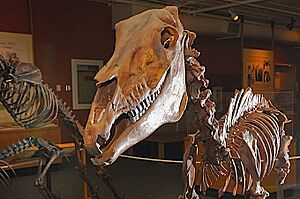
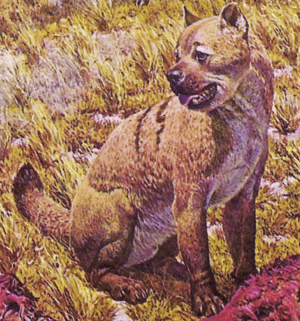
Scientists have found many different kinds of animal fossils at Mount Blanco. These fossils help us understand what life was like millions of years ago. Most of the fossils are scattered bones, but sometimes whole skeletons have been found.
For example, a famous skeleton of an ancient horse, Equus simplicidens, was found here. Scientists also found the remains of about 18 giant camels called Titanotylopus. Other important finds include the skull of a saber-toothed cat relative, Dinofelis palaeoonca, and the shell of a giant armadillo-like animal, Glyptotherium.
The fossils found at Mount Blanco are very similar to those found at another important site in Kansas. The age of the Blanco fauna is mainly determined by these ancient animal fossils. Some animals found here, like Borophagus (an ancient dog) and Rhynchotherium (an ancient elephant relative), did not survive past the Blancan age. Other animals, like Camelops (an ancient camel) and Platygonus (an ancient peccary), first appeared during this time.
Here are some of the amazing animals whose fossils have been found at Mount Blanco:
- Giant Armadillo Relatives
- †Glyptotherium texanum (a large, armored animal)
- †Megalonyx leptostomus (a giant ground sloth)
- †Paramylodon sp. (another type of giant ground sloth)
- Ancient Elephants and Mastodons
- †Rhynchotherium falconeri (an ancient elephant relative with long tusks)
- †Stegomastodon mirificus (another ancient elephant relative)
- Indeterminate †Mammut (an ancient mastodon)
- Hoofed Mammals
- Indeterminate antilocaprid (an ancient relative of pronghorns)
- †Blancocamelus meadei (an ancient camel)
- †Camelops cf. traviswhitei (another ancient camel)
- †Hemiauchenia blancoensis (a long-necked ancient camel)
- †Titanotylopus spatulus (a very large ancient camel)
- Indeterminate camelid (another ancient camel)
- †Odocoileus cf. brachyodontus (an ancient deer)
- †Platygonus bicalcaratus (an ancient peccary, similar to a wild pig)
- Ancient Horses
- †Equus cumminsi (an ancient horse)
- †Equus simplicidens (another ancient horse, sometimes called the Hagerman horse)
- †Nannippus peninsulatus (a small, three-toed ancient horse)
- Carnivores (Meat-eaters)
- †Borophagus diversidens (an ancient bone-crushing dog)
- †Canis lepophagus (an ancient wolf-like dog)
- †Felis cf. lacustris (an ancient cat)
- †Dinofelis palaeoonca (a saber-toothed cat relative)
- †?Homotherium (another type of saber-toothed cat)
- †?Chasmaporthetes ossifragus (an ancient hyena)
- †Canimartes cumminsi (an ancient weasel relative)
- †Spilogale rexroadi (an ancient skunk)
- Other Mammals
- ?Tadarida sp. (an ancient bat)
- †Sorex taylori (an ancient shrew)
- †Hesperoscalops blancoensis (an ancient mole)
- †Hypolagus sp. (an ancient rabbit)
- †Nekrolagus cf. progressus (another ancient rabbit)
- Baiomys sp. (a type of mouse)
- †Bensonomys sp. (an ancient mouse)
- †Neotoma cf. quadriplicatus (an ancient woodrat)
- Onychomys sp. (a type of grasshopper mouse)
- † Peromyscus cf. kansasensis (an ancient deer mouse)
- Reithrodontomys sp. (a type of harvest mouse)
- †Sigmodon medius (an ancient cotton rat)
- Geomys sp. (a type of gopher)
- †Perognathus cf. pearlettensis (an ancient pocket mouse)
- †Perognathus cf. rexroadensis (another ancient pocket mouse)
- †Prodipomys centralis (an ancient kangaroo rat)
- †Paenemarmota barbouri (a giant ancient marmot)
- †?Otospermophilus sp. (an ancient ground squirrel)
- †Ictidomys howelli (an ancient ground squirrel)
Images for kids
See also
 In Spanish: Cerro Blanco (Texas) para niños
In Spanish: Cerro Blanco (Texas) para niños


